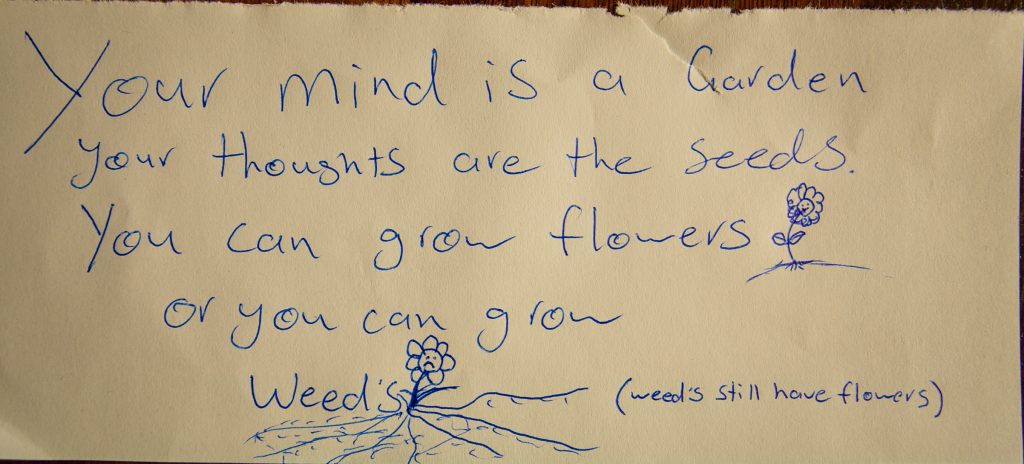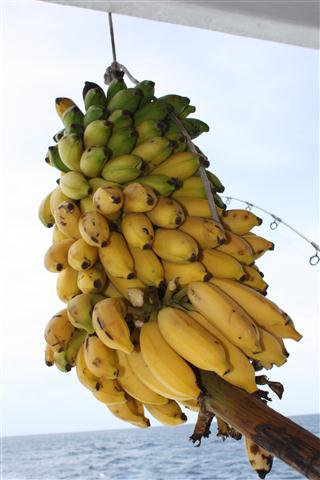Reflections on the impacts of globalization, the melting pot of food, culture, markets, large scale industrialized food production and the relationship between how we fuel our bodies… as well as our minds???
Banana phone selfies in Banff.
So bananas… Its hard to imagine a world without them right?
The above 1940’s advertisment for Bananas was shown to me by some good friends one evening. Its crazy to reflect on how recently bananas were commercialized and exported around to globe to markets far away from the more tropical regions in witch they grow. Today Chiquita sells bananas in about 70 countries making it the biggest banana company in the world.
In the banana industry, production, profits, and power are highly concentrated. Just five corporations control around 80% of the world’s banana import market.
Bananas are incredible and definitely help you shred… With out delving too much into it they are nutritionally a great place to find all of the potassium and loads of other good stuff your active body needs.
They are generally pretty abundant where i grew up in Australia with the exception of the occasional cyclone wiping out crops in north QLD.
In running away from home and moving over to Canada it occurred to me that Bananas were probably not grown in this northern winter wonderland.
Aspiring to eat locally and seasonally it was difficult to accept the reality that this meant potentially buying Bananas (and other products) that were grown in intensive agricultural regimes far far away.
As is often the case with globalized food regimes cutting corners to maximize profit is pretty standard. These hidden costs often go unaccounted for and companies often compromise social and environmental responsibilities because to the consumer…. heck its out of sight and out of mind.
As one of the most traded commodities in the world coffee also grows in a similar climate to bananas. Its production in developing countries for consumption in markets far away in more industrialized economies can be seen to follow a similar trend.
“Over 2.25 billion cups of coffee are consumed in the world every day.[1] Over 90% of coffee production takes place in developing countries, while consumption happens mainly in the industrialized economies.[1]”
“In 2009, Canada imported US$334.2 million of bananas, 95 per cent of which come from low cost suppliers in Central and South America such as Ecuador, Guatemala, Peru, Columbia, Honduras and Panama. Out of these bananas, only one per cent of them are certified as ethically produced fair trade bananas. The other 99 per cent, however, poses an important challenge to us as Canadians — what do we as a society value more, our wallets or our morality?” Rabble
Based on increasing consumer demand we have seen efforts in more recent times to transform the coffee and food industry through initiatives such as fair trade and organic labeling. Whilst Fair trade coffee only represents 4% of the current global market it has seen a major growth in the past five years.
Irrespective of weather its coffee, Bananas or other agricultural and food products it is important to note that the substantial majority of globally traded commodities still remains un-certified as fair trade or organic and without labeling or certification schemes in place, consumers are left in the dark as to where their food is coming from or in some instances what they are even actually purchasing.
Bike trip bananas.
Its quite crazy to reflect that the major agricultural corporations have to established a regime where by food is labeled as organic as an exception to what has become known simply as “conventional” agriculture, even tho all that ever existed before the 1960’s was “organic” agriculture by definition.
“Organic agriculture is an ecological production management system that promotes and enhances biodiversity, biological cycles and soil biological activity. It is based on minimal use of off-farm inputs and on management practices that restore, maintain and enhance ecological harmony.” USDA
So what then exactly is modern western “conventional” agriculture?
In order to intensify yields and maximize food production and associated profits agriculture has undergone a major transformation in the past century. This has included the introduction of chemicals in the form of pesticides and fertilizes as well as more mechanized farming methods with technological innovation replacing humans and animals with machines to both tend to crops as well as refrigerate and transport food to market. This has resulted in food being viably be produced in such a massive scale it can be transported and sold to markets literally on the other side of the world.
This has seen large companies within North America buy up extensive areas of farm land for agriculture and food production and with the assistance of all of this new technology a truly industrialized food regime now exists. These farms ultimately focus on quantity and not quality and as a result the food produced is often less nutritious. Take eggs for example… its plain to visually see the difference in the quality of eggs produced in factory caged feed lots compared with those from free range organic producers.
Just to step back for a second tho, lets consider the question why do we eat???
Because we are hungry, yes sure… but ultimately on a cellular level, our bodies are chasing the right mix of proteins, carbohydrates, vitamins and minerals that they need to keep on keeping on. On a psychological level our brains are programmed to enjoy the sensation of taste and selectively enjoy sugary sweets over bland alternatives. The more you use and abuse your body the more you notice how it responds to what your are or are not eating and over time it would pretty quickly become apparent that eating yummy things like lollies for breakfast, lunch and dinner wont sustain your energy levels for very long. So we obviously need to eat based on our nutritional needs depending on how we spend our days in the short term, but what about in the longer term?
Porridge lyfe ft. Bananas.
What if like many animals living in areas around agricultural production that are contaminated with pesticides us humans were also ingesting small amounts of the chemicals and pesticides used as a part of our food production? Could these bio-accumulate and possibly effect our health? What if there was a link between intensive food production and the rates of cancer and other health problems?
With so much processing and packaging of food its hard to know what you are really buying is let alone where its coming from and if it might have been genetically modified. In trying to create more awareness on this issue and give the power back to consumers choose what they do and don’t want to put into their bodies there has been mounting political pressure to introduce GMO/Organic labeling in North America. The argument being, if GMO’s are safe then why not label them?
This parody clip on the topic is also incredible!
Its also crazy but McDonalds are currently actually running a campaign to convince people that their food is even REAL?
Vegetarianism is maybe a good place to start…but what about killing and eating organic local and sustainably harvested produce?
Sadly the numbers show that whilst there is and emerging trend in consumer consciousness with the emergence of various food labeling initiatives, the majority of North Americas Bellies are fed by massive supermarkets who are able to drown out any competition with ridiculously low prices.
But this is not only the case in North America… in the UK Milk is now cheaper than water???
Its one thing to go organic, no gmo, go vego but above and beyond all that we need to try and eat locally, seasonally and in turn more sustainably?
Maybe this means no bananas in Canada?
With N.A.S.A recently calculating that the state of California has less the one years water supply left the question has been raised, what will the impact be on one of North Americas largest agricultural areas?
This infographic paints a pretty scary picture indeed!

Maybe part of the solution also lies in regressing back to pre-industrialization methods of food production and in eating locally diverging from energy intensive refrigeration and transportation. What ever happened to canning, pickling, salting, drying & smoking..? To reusable containers as opposed to single use plastic packaging?
The social and environmental impacts of large scale globalized industrial agriculture touched on above are just the beginning of some of the negative impacts associated with industrialized food production. What about eating this food and the health of our populations?
“Two-thirds of American adults are overweight…. If current trends continue, by 2030 nearly half of American adults could be obese.” Economist
Further more, the wealthy are able to afford to pay for healthier, higher quality diet and fresh food remain while the poor eat lower quality food that is made cheap and affordable at supermarkets.
“In Mexico unreliable tap water and savvy marketing have helped make the country the world’s leading guzzler of Coca-Cola: the average adult consumed 728 servings last year.”Economist
“Diet quality has improved among people of high socioeconomic status but deteriorated among those at the other end of the spectrum. The gap between the two groups doubled between 2000 and 2010. That will be costly for everyone.” The Atlantic
Further more the crazy inefficiencies this agricultural supply vs demand nightmare result in “165 billion dollars worth of food being thrown away per year in America. About 50 million of our 317 million Americans are food insecure yet we produce enough food to feed over 500 million Americans.” Rob Greenfield
Recently France introduced legislating making it illegal for super markets to throw out food! Definitely a step in the right direction.
But if you ask Monsanto, one of the “Big 6” pesticide and GMO corporations, the question “why does agriculture need to be improved” they claim…
This argument forms the back bone of the pro-GMO debate which as per monsanto’s claims GMO’s are needed if we are to be able to successfully feed the worlds growing population. Perhaps we just need more efficiency, and not as much overproduction and wastage of food?
The crazy thing to realize is that we live in a day and age where the rich get skinny, the middle class get fat and they all throw away food while the poor still starve?
“When food, in the minds of eaters, is no longer associated with farming and with the land, then the eaters are suffering a kind of cultural amnesia that is misleading and dangerous. The passive American consumer, sitting down to a meal of pre-prepared or fast food, confronts a platter covered with inert, anonymous substances that have been processed, dyed, breaded, sauced, gravied, ground, pulped, strained, blended, prettified, and sanitized beyond resemblance to any part of any creature that ever lived. The products of nature and agriculture have been made, to all appearances, the products of industry. Both eater and eaten are thus in exile from biological reality. And the result is a kind of solitude, unprecedented in human experience, in which the eater may think of eating as, first, a purely commercial transaction between him and a supplier and then as a purely appetitive transaction between him and his food.
And this peculiar specialization of the act of eating is, again, of obvious benefit to the food industry, which has good reasons to obscure the connection between food and farming. It would not do for the consumer to know that the hamburger she is eating came from a steer who spent much of his life standing deep in his own excrement in a feedlot, helping to pollute the local streams, or that the calf that yielded the veal cutlet on her plate spent its life in a box in which it did not have room to turn around. And, though her sympathy for the slaw might be less tender, she should not be encouraged to meditate on the hygienic and biological implications of mile-square fields of cabbage, for vegetables grown in huge monocultures are dependent on toxic chemicals—just as animals in close confinement are dependent on antibiotics and other drugs.
The consumer, that is to say, must be kept from discovering that, in the food industry—as in any other industry—the overriding concerns are not quality and health, but volume and price. For decades now the entire industrial food economy, from the large farms and feedlots to the chains of supermarkets and fast-food restaurants, has been obsessed with volume. It has relentlessly increased scale in order to increase volume in order (presumably) to reduce costs. But as scale increases, diversity declines; as diversity declines, so does health; as health declines, the dependence on drugs and chemicals necessarily increases. As capital replaces labor, it does so by substituting machines, drugs, and chemicals for human workers and for the natural health and fertility of the soil. The food is produced by any means or any shortcut that will increase profits. And the business of the cosmeticians of advertising is to persuade the consumer that food so produced is good, tasty, healthful, and a guarantee of marital fidelity and long life.”
So if organic, non genetically modified, locally produced and seasonally grown or sustainably preserved food is where we need to transition to, how to we get there?
Is it all about creating some food for though?
What we fuel our bodies with is of course determined by what we fuel our minds with. If we take the time to consider what the flow on effects of what we consume are and purchase accordingly where and when we can afford to do so over time market forces will in theory adjust. The real challenge is in engaging with the masses and creating awareness.
In the same sense that what we eat becomes who we are physicaly, what we expose our brains to inevitably influences how we think and behave. Through cleaver advertising and marketing in a day and age of electronic chaos and over mental stimulation it can be hard to realize the influence that this may even have on our subconscious decision making and impulse buys as consumers. The trick is i guess to be selective as to what you read or watch or even listen to in the same way you might look over fresh produce in a grocery store and be critical.
To change the way people interact with our planet we must first change the way of thinking and in doing so change peoples habits and behaviors.
Change your mind to change to world…

One final thing…
The experiments of Harry Harlow and his associates at the Primate Laboratory of the University of Wisconsin are described in the textbook Principles of General Psychology (1980 John Wiley and Sons)

Its awesome to see the cogs are turning and these issues are getting more attention around the world in more mainstream media avenues.
https://www.youtube.com/watch?v=5Ug_vpIk1jc
and even in music….

More reading and stuff to check out on this topic…
http://michaelpollan.com/books/the-omnivores-dilemma/
http://wholelarderlove.com/

